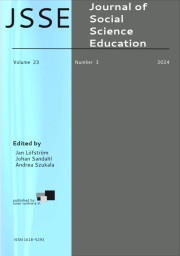Mapping elementary students' understandings of the police
DOI:
https://doi.org/10.11576/jsse-6865Keywords:
police, social institutions, phenomenography, civics, teachingAbstract
Highlights:
– Research on conceptual change in civics is needed.
– Phenomenography is useful for mapping different ways of understanding a particular concept, in this case, the different ways elementary students understand the police.
– Civics teaching can benefit from mapping understandings of phenomena such as different social institutions.
Purpose: Investigate first- to third-graders’ understandings of the police.
Design/methodology/approach: Phenomenography is used to analyze elementary students’ understandings of the police as a social institution
Findings: The results indicate three qualitatively different ways of understanding the police. The police as: attributes, activities and as a part of the democratic welfare state.
Practical implications: Civics teaching that aims to develop students’ understandings of the police can benefit from taking the three different ways of understanding into consideration.
Downloads
Published
How to Cite
Issue
Section
License
Copyright (c) 2024 JSSE - Journal of Social Science Education

This work is licensed under a Creative Commons Attribution-ShareAlike 4.0 International License.



